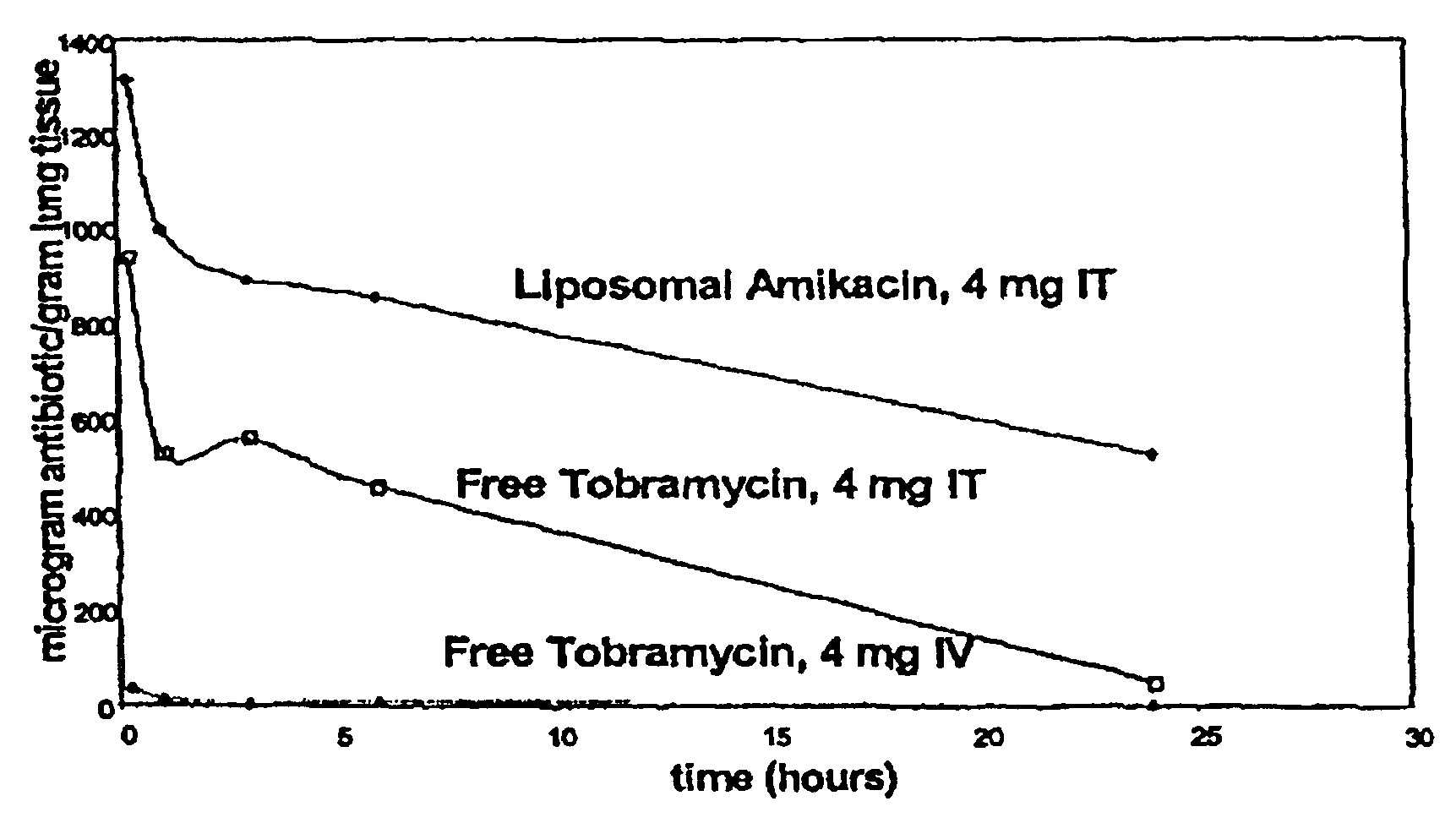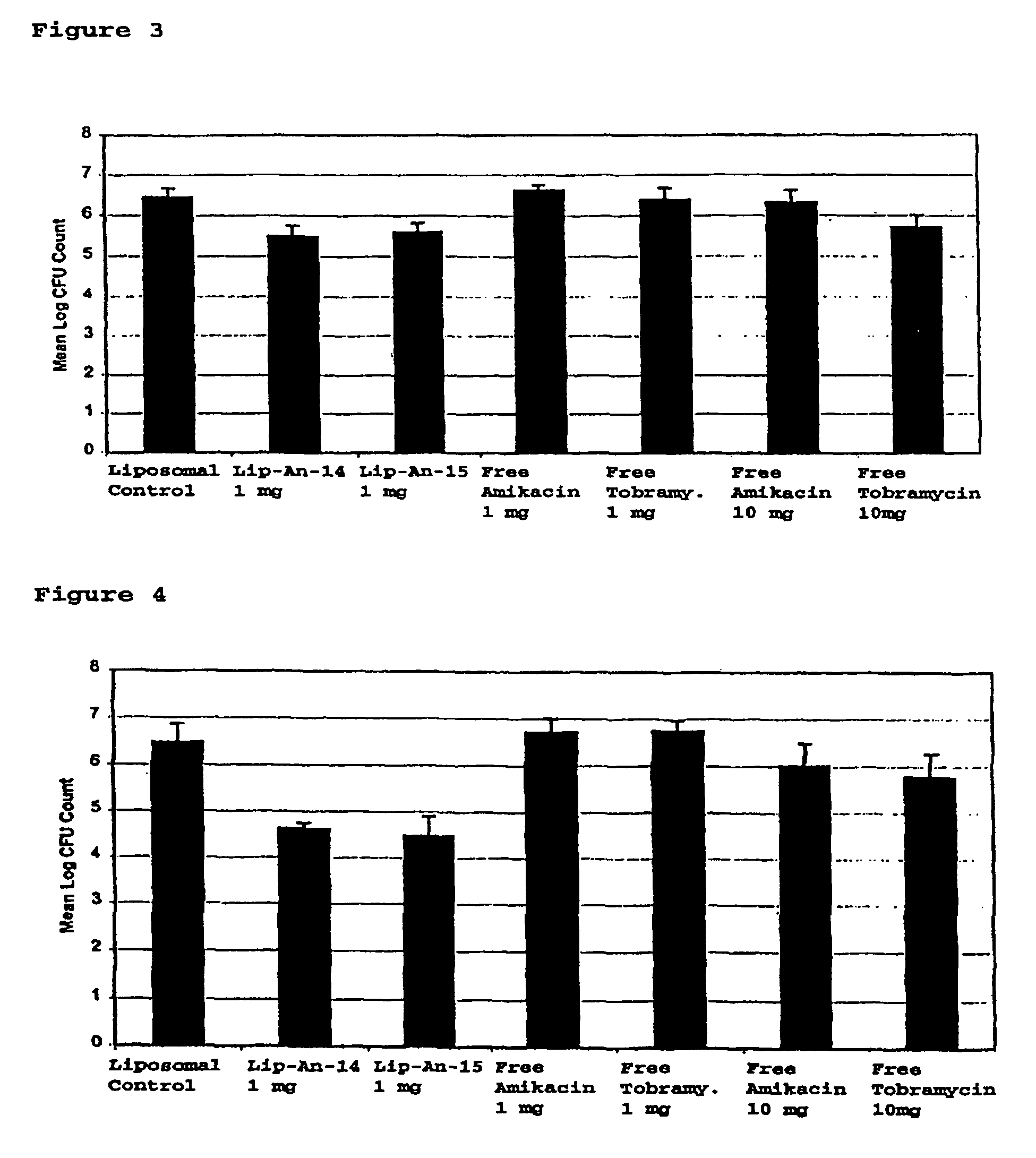Sustained release of antiinfectives
a technology of antiinfective and sustained release, which is applied in the direction of antibacterial agents, drug compositions, dispersed delivery, etc., can solve the problems of limiting the administration and thus the effectiveness of drug products, and achieve the effect of reducing the ratio of lipids to antiinfective agents
- Summary
- Abstract
- Description
- Claims
- Application Information
AI Technical Summary
Benefits of technology
Problems solved by technology
Method used
Image
Examples
example 1
[0206]The following is a detailed description of the manufacture of 150 mL of Liposomal / complexed amikacin.[0207]Total Intial Volume=1.5 L[0208]Ethanol Content=23.5% (v / v)[0209]Lipid Composition: DPPC / Chol (1:1 mole ratio)[0210]Intial [Lipid]=7.6 mg / mL[0211]Intial [amikacin sulfate]=57.3 mg / mL[0212]Final product Volume=150 mL
[0213]I) Compounding and Infusion:
[0214]7.47 g DPPC and 3.93 g Cholesterol were dissolved directly in 352.5 mL ethanol in a 50 C water bath. 85.95 g amikacin sulfate was dissolved directly in 1147.5 mL PBS buffer. The solution is then titrated with ION NaOH or KOH to bring the pH to approximately 6.8.
[0215]352.5 mL ethanol / lipid was added or infused to the 1147.5 mL amikacin / buffer to give a total intial volume of 1.5 L. The ethanol / lipid was pumped @−30 mUmin (also called infusion rate) with a peristaltic pump into the amikacin / buffer solution which was being rapidly stirred at 150 RPM in a reaction vessel on a stir plate at room temperature
[0216]The product wa...
example 2
High Liposomal Entrapment of Amikacin.
[0220]Four samples of lipid antiinfective formulations were prepared at various lipid and antiinfective concentrations according to the following procedures.[0221]Sample #1. Amikacin sulfate 1.72 kg was dissolved in 23 Liters saline solution (0.9% NaCl) and pH was adjusted to 6.5 by adding necessary amount NaOH. Lipids—98.2 g DPPC and 51.8 g Cholesterol were dissolved in 7 liters ethanol. Liposomes were formed by infusion of lipid solution into amikacin solution at a rate of ˜600 mL / min and under constant stirring. Resulting suspension was then washed to remove ethanol and un-entrapped amikacin by diafiltration using an Amersham Hollow Fiber cartridge 500 kD pore size. The suspension was concentrated to a final volume of ˜3.5 L.[0222]Sample #2. The procedure was similar to that for sample #1 with all material quantities scaled down 100 fold. Amikacin sulfate 17.2 g was dissolved in 230 mL saline solution (0.9% NaCl) and pH was adjusted to 6.6 by...
example 3
High Liposomal Entrapment of Gentamicin.
[0225]Sample #5. Gentamicin sulfate 20.0 g was dissolved in 230 mL saline solution (0.9% NaCl) and pH was adjusted to 6.5 by adding necessary amount of sulfuric acid. Lipids—0.982 g DPPC and 0.518 g Cholesterol were dissolved in 70 mL ethanol. Liposomes were formed by infusion of lipid solution into gentamicin solution at a rate of ˜500 m / min and under constant stirring. Un-entrapped gentamicin and ethanol were removed by diafiltration using an Amersham Hollow Fiber cartridge. The suspension was concentrated to a final volume of ˜35 mL.[0226]Sample #6. The procedure was similar to that for sample #5, except: Gentamicin sulfate 17.0 g was dissolved in 230 mL Na2SO4 100 mM solution and pH was adjusted to 6.5 by adding necessary amount of H2SO4. Lipids—0.982 g DPPC and 0.518 g Cholesterol were dissolved in 75 mL ethanol.
PUM
| Property | Measurement | Unit |
|---|---|---|
| mean diameter | aaaaa | aaaaa |
| size | aaaaa | aaaaa |
| mean diameter | aaaaa | aaaaa |
Abstract
Description
Claims
Application Information
 Login to View More
Login to View More - R&D
- Intellectual Property
- Life Sciences
- Materials
- Tech Scout
- Unparalleled Data Quality
- Higher Quality Content
- 60% Fewer Hallucinations
Browse by: Latest US Patents, China's latest patents, Technical Efficacy Thesaurus, Application Domain, Technology Topic, Popular Technical Reports.
© 2025 PatSnap. All rights reserved.Legal|Privacy policy|Modern Slavery Act Transparency Statement|Sitemap|About US| Contact US: help@patsnap.com



